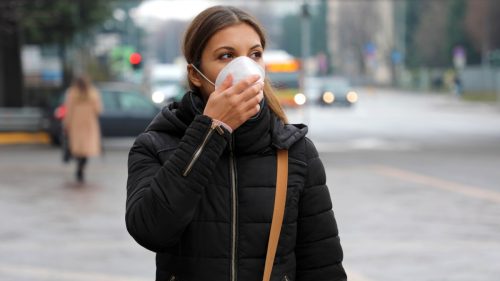23 States With "Very High" COVID Levels, New CDC Data Shows
The agency collects data from wastewater across the country to determine viral activity.

With the Christmas holiday and the new year fast approaching, calendars tend to fill with parties and family gatherings. But while we look forward to these holiday get-togethers, since 2020, we've also had to worry about contracting or spreading COVID. Ahead of Thanksgiving, the Centers for Disease Control and Prevention (CDC), issued warnings about staying safe during the holidays, but numbers have risen in the U.S. since Turkey Day, with a 0.4 percent decrease in test positivity as of Dec. 9 and a 3.1 percent increase in hospital admissions. While these numbers represent the U.S. as a whole, the CDC also uses a different kind of data to pinpoint states where COVID levels are high.
RELATED: 2 COVID Symptoms Now Tied for Most Common Virus Signs, Doctors Say.
The CDC routinely updates the COVID-19 Current Wastewater Viral Activity Levels Map, which "shows current viral activity levels of SARS-COV-2 in wastewater." According to the website, sewage can be used to detect traces of infectious diseases in communities, even if people don't have symptoms. This data can then be used "as an early warning that levels of infections may be increasing or decreasing in your community," the CDC says.
The agency outlines its testing process, noting that people with infections like COVID shed pieces of the virus when they use the bathroom, wash their hands, shower, or do laundry. The pieces then go through the drain to the sewage system, and before the wastewater is treated, samples are taken and sent to a laboratory for testing. All 50 states have wastewater monitoring—though not all are currently reporting—and approximately 1,077 sites reported to the NWSS in the last two months. Per the CDC, the system is estimated to cover around 117,000,000 Americans, or 35 percent of the U.S. population.
According to the CDC, data collected by the National Wastewater Surveillance System (NWSS) can "show changes in disease trends before trends are seen in clinical cases." When equipped with this data, local healthcare providers and hospitals prepare for potential upticks in visits and hospitalizations—and it can also track the different variants that are present or spreading in communities.
The CDC uses the interactive viral activity levels map to show which states are showing very high, high, moderate, low, minimal, or unknown COVID levels. (To determine where states fall, the NWSS measures changes in SARS-CoV-2 virus levels from each testing plant's baseline measurements.)
So, if you have travel plans out-of-state or if you're hosting long-distance relatives at home, you might want to take stock of the current measurements. Read on to find out where wastewater indicates COVID-19 levels are the highest.
RELATED: These Are the 9 Symptoms of the New JN.1 COVID Variant, Doctors Say.
Minimal/low

Per the latest data, which was updated on Dec. 9, Oregon's levels are "minimal," which is the lowest level on the CDC scale. Alaska, Hawaii, and Washington all have "low" COVID wastewater viral activity levels.
Moderate

Florida, Georgia, Kentucky, and Pennsylvania have "moderate" COVID activity levels, per wastewater testing.
RELATED: Doctor Reveals COVID Symptoms in Patients Who Haven't Gotten a Fall Booster.
High

Twelve states have high levels: Alabama, Arizona, California, Colorado, Kansas, Nevada, New York, Rhode Island, Tennessee, Texas, Utah, and Virginia.
Very high

The "very high" COVID activity level group is the largest, with 23 states falling into this category. Per the most recent CDC data, Arkansas, Delaware, Idaho, Illinois, Indiana, Iowa, Maine, Maryland, Massachusetts, Michigan, Minnesota, Missouri, Montana, Nebraska, New Hampshire, New Jersey, North Carolina, Ohio, South Carolina, South Dakota, Vermont, West Virginia, and Wisconsin all have very high viral activity levels.
RELATED: Why the New COVID Variant Could Make You Sick Longer, Doctor Says.
No data available

A handful of states and U.S. territories lack data about COVID levels because they don't have any sampling sites currently reporting to the NWSS. There is no data for Connecticut; Washington, D.C.; Louisiana; Mississippi; New Mexico; North Dakota; Oklahoma; and Wyoming. The U.S. Virgin Islands, Puerto Rico, and Guam also have no sites that are reporting as of Dec. 9.
The CDC notes that testing resumed at about 350 commercial contract wastewater sites after they were temporarily delayed on Sept. 15. Once six weeks of data have been collected, the wastewater viral levels will be updated.
RELATED: For more up-to-date information, sign up for our daily newsletter.





















